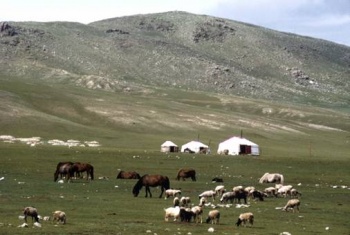Examples of Index-based microinsurance schemes
Index-based insurance for livestock in Mongolia

Herders in Mongolia. Picture: George Holden
Livestock herding plays a very important role in Mongolia, contributing to 87% of agricultural GDP, and the importance of herding to the livelihoods of rural people has increased since the decline of collectivized agriculture (the number of herding families doubled from 1990-1997). Livestock herders are vulnerable to large losses due to drought or dzuds (very severe winters/springs), and traditional coping strategies or government aid are often not enough to mitigate the problems that these severe events cause. For example during the dzuds of 2000-2002 it is estimated that 11m animals died. In addition, government or donor aid provides very little incentive to herders to reduce the risk to their herds. Improved pastoral risk management is an integral part of Mongolia’s Poverty Reduction Strategy.
Conventional insurance for livestock has not worked in the Mongolian context due to problems of moral hazard (if losses are replaced there is no incentice to reduce risk) and difficulties in verifying claims in the wide expanses of Mongolia. The World Bank has been working with the government of Mongolia to develop an index-based scheme as an alternative to support pastoral risk management.
The scheme
Based on historic data about livestock losses, an index has been developed where payouts to herders occurs when livestock losses at the regional scale exceed a trigger point (7%), and become larger the greater the livestock losses are, until an ‘exhaustion point (25% or 30%). A government run ‘disaster response product’ begins to pay out if losses exceed the exhaustion point. Herders take out premiums based on the value of their animals and the number that they want to insure, and then if regional losses exceed the trigger point there is a sliding scale of increasing payment until the exhaustion point. The premium buys the herders the Basic insurance product, which covers them for regional losses up to 25-30%, and automatically registers them for the government run Disaster response product which begins to pay out if regional losses are above this, so in effect provides a safety net. Being based on regional losses, the scheme avoids the problem of moral hazard, as a herder who protects his animals better than his neighbour will still receive the same pay-out, but will benefit by having more animals survive.
So the insurance scheme actually operates in three tiers; small losses are absorbed by the herders themselves through traditional measures, large events cause the private sector to pay-out to herders, and catastrophic events where losses larger than the exhaustion point of the scheme occur, cause the government scheme to provide additional payouts. This limits the losses to the commercial insurers, encouraging them to be involved in the scheme.
- Up to 7% regional losses: No payout, herders must absorb the losses
- 7-25 or 30% regional losses: Basic insurance product (run by commercial companies) pays out
- Above 30% regional losses: Disaster response product (run by government) begins pay-outs.
Sources:
World Bank Mongolia Index-insurance project
Mahul, O. and Skees, J. Piloting index-based livestock insurance in Mongolia.
(0) Comments
There is no content